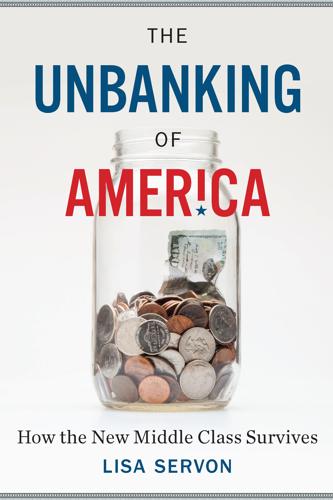
The Unbanking of America: How the New Middle Class Survives
by
Lisa Servon
Published 10 Jan 2017
xvii “banked” (they use only banks): Burhouse et al., “2013 National Survey of Unbanked and Underbanked Households.” One in five African American households: Ibid. “mainstream banking services”: Julie Menin, “Bad Alternative to Banks,” letter to the editor, New York Times, November 14, 2014. xviii Jacob Hacker writes that: Jacob Hacker, The Great Risk Shift: The New Economic Insecurity and the Decline of the American Dream (Oxford, UK: Oxford University Press, 2008). A recent study conducted by: Burhouse et al., “2013 National Survey of Unbanked and Underbanked Households.” xix put their trust in banks: GlobeScan, “Seven Years on from the Financial Crisis, Trust in Banks Remains at All-Time Low” (Toronto, Ontario: GlobeScan, July 2, 2015). http://www.globescan.com/news-and-analysis/blog/entry/seven-years-on-from-the-financial-crisis-trust-in-banks-remains-at-all-time-low.html 1.
…
Additionally, in response to the claim that the maintenance of a bank account is a sign of stability, I say this: In a labor market such as ours, where the college diploma has been wholly devalued, where median wages have remained stagnant for far too long, and where firms dispense of people as if they were unnecessary appendages, to what degree is financial stability actually attainable? And at what cost? While people try to adapt to these changing situations, policymakers’ view of personal finance has remained static. The Federal Deposit and Insurance Corporation (FDIC) conducts the biannual “National Survey of Unbanked and Underbanked Households.” The survey classifies respondents as “banked” (they use only banks and credit unions), “unbanked” (they have no bank account), or “underbanked” (they have bank accounts but continue to rely on alternative financial services). As of 2013, the year of the FDIC’s most recent survey, approximately 8 percent of Americans were unbanked and another 20 percent were underbanked.
…
As of 2013, the year of the FDIC’s most recent survey, approximately 8 percent of Americans were unbanked and another 20 percent were underbanked. The picture looks far worse for people of color. One in five African American households and nearly 18 percent of Latino households are unbanked. Policymakers, alarmed by these statistics, have been working hard to enfranchise the unbanked and underbanked. They insist that a formal relationship with a mainstream financial institution will improve these people’s lives. Convinced that having a bank account enables one to move up the economic ladder, they paint banks as the good guys and alternatives as the bad guys. This simplistic view reflects unstated value judgments.

How the Other Half Banks: Exclusion, Exploitation, and the Threat to Democracy
by
Mehrsa Baradaran
Published 5 Oct 2015
This is the story of South Africa’s foray into mobile banking: In South Africa, where only half the population has bank accounts, but nearly everyone has a mobile phone, a company called WIZZIT set out to bank the unbanked with an aspiring worldwide mission to “change the world by providing banking opportunities to the 4 billion unbanked and under-banked [globally] through cell phone technology, leading to a reduction in poverty and the creation of economic citizens.”79 However, the company not only failed to reduce poverty worldwide, but as it turned out, the banked and higher-income population, who relied on the service to conduct more banking transactions at increased convenience, comprised most of its South African customer base.
…
Consumer Financial Protection Bureau, “Nashville, TN: Field Hearing on Payday Loans,” March 2014, accessed March 17, 2015, youtu.be/ZpnXG0UdeoQ; CFPB, “Payday Loans and Deposit Advance Products,” April 24, 2013, 15; CFPB White Paper of Initial Data Findings, accessed March 17, 2015, files.consumerfinance.gov/f/201304_cfpb_payday-dap-whitepaper.pdf; Susan Urahn et al., “Payday Lending in America: Who Borrows, Where They Borrow, and Why,” Pew Charitable Trust, 2012, 32, accessed March 17, 2015, www.pewtrusts.org/~/media/legacy/uploadedfiles/pcs_assets/2012/PewPaydayLendingReportpdf.pdf. 56. FDIC, “National Survey of Unbanked and Underbanked Households,” Executive Summary, September 2012, 5, accessed March 17, 2015, www.fdic.gov/householdsurvey/2012_unbankedreport_execsumm.pdf; Gregory Elliehausen and Edward C. Lawrence, “Payday Advance Credit in America: An Analysis of Consumer Demand,” Georgetown University McDonough School of Business Credit Research, monograph no. 35, 2001, 28, 33, accessed March 17, 2015, www.fdic.gov/bank/analytical/cfr/2005/jan/CFRSS_2005_elliehausen.pdf. 57.
…
Households in 2013,” July 2014, 5, accessed March 17, 2015, www.federalreserve.gov/econresdata/2013-report-economic-well-being-us-households-supplemental-appendix-201407.pdf; A 2011 National Bureau of Economic Research study showed about half of households surveyed reported that they couldn’t come up with $2,000 within thirty days in a pinch, even if they turned to relatives for help. Annamaria Lusardi et al., “Financially Fragile Households: Evidence and Implications,” (NBER working paper no. 17072, May 2011), accessed March 17, 2015, www.nber.org/papers/w17072; A 2011 FDIC survey put 29.3 percent of households without a savings account. FDIC, “Unbanked and Underbanked Households,” 3. 62. Dan Mangan, “Medical Bills Are the Biggest Cause of U.S. Bankruptcies: Study,” CNBC, June 25, 2013, accessed March 17, 2015, www.cnbc.com/id/100840148. 63. Federal Reserve Board of Governors, “Report on the Economic Well-Being of U.S. Households in 2013,” accessed March 17, 2015, www.federalreserve.gov/econresdata/2013-report-economic-well-being-us-households-201407.pdf; www.nytimes.com/2014/12/04/business/unsteady-incomes-keep-millions-of-workers-behind-on-bills-.html, accessed March 17, 2015. 64.
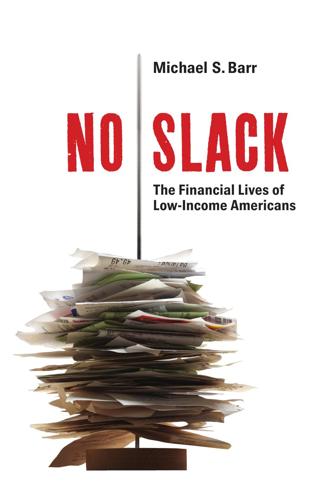
No Slack: The Financial Lives of Low-Income Americans
by
Michael S. Barr
Published 20 Mar 2012
Farley, Reynolds, Sheldon Danziger, and Harry J. Holzer. 2000. Detroit Divided. New York: Russell Sage Foundation. Fay, Scott, Erik Hurst, and Michelle J. White. 2002. “The Household Bankruptcy Decision.” American Economic Review 92:706–18. FDIC (Federal Deposit Insurance Corporation). 2009. FDIC National Survey of Unbanked and Underbanked Households (www.fdic.gov/householdsurvey/full_report.pdf). FRS (Federal Reserve System). 2010. The 2010 Federal Reserve Payments Study (www. frbservices.org/files/communications/pdf/press/2010_payments_study.pdf). FRTIB (Federal Retirement Thrift Investment Board). 2007. Thrift Savings Plan Participant Survey Results, 2006–07 (www.frtib.gov/pdf/FOIA/2006-TSP-Survey-Results.pdf).
…
“Payday Advance Credit in America: An Analysis of Customer Demand.” Monograph 35. Washington: Georgetown University, McDonough School of Business (www.fdic.gov/bank/analytical/cfr/2005/jan/ CFRSS_2005_elliehausen.pdf). FDIC (Federal Deposit Insurance Corporation). 2009. FDIC National Survey of Unbanked and Underbanked Households (www.fdic.gov/householdsurvey/full_report.pdf). Green, Paul E., and V. Srinivasan. 1978. “Conjoint Analysis in Consumer Research: Issues and Outlook.” Journal of Consumer Research 5:103–23 (www.jstor.org/stable/2489001). 12864-02_CH02_3rdPgs.indd 52 3/23/12 11:55 AM managing money 53 Kish, Leslie. 1949.
…
(December). (www.swarthmore.edu/Documents/ academics/economics/beyond_cash_and_carry.pdf). Dove Consulting. 2000. “Survey of Non-Bank Financial Institutions for the Department of Treasury.” Report prepared for the U.S. Treasury Department (April 4). ———. 2008. “Banks’ Efforts to Serve the Unbanked and Underbanked.” Report prepared for the Federal Deposit Insurance Corporation (December). Doyle, Joseph J., Jose A. Lopez, and Marc R. Saidenberg. 1998. “How Effective Is Lifeline Banking in Assisting the ‘Unbanked’?” Federal Reserve Bank of New York Current Issues in Economics and Finance 4, no. 6: 1–6 (www.newyorkfed.org/research/current_issues/ci4-6. pdf ).

Blockchain Revolution: How the Technology Behind Bitcoin Is Changing Money, Business, and the World
by
Don Tapscott
and
Alex Tapscott
Published 9 May 2016
Trading is the buying and selling of assets and financial instruments for the purpose of investing, speculating, hedging, and arbitraging and includes the posttrade life cycle of clearing, settling, and storing value. Blockchain cuts settlement times on all transactions from days and weeks to minutes and seconds. This speed and efficiency creates opportunities for unbanked and underbanked people to participate in wealth creation. 6. Funding and Investing: Investing in an asset, company, or new enterprise gives an individual the opportunity to earn a return, in the form of capital appreciation, dividends, interest, rents, or some combination. The industry makes markets: matching investors with entrepreneurs and business owners at every stage of growth—from angels to IPOs and beyond.
…
Exchanging Value—speculating, hedging, and arbitraging. Matching orders, clearing trades, collateral management and valuation, settlement and custody Blockchain takes settlement times on all transactions from days and weeks to minutes and seconds. This speed and efficiency also creates opportunities for unbanked and underbanked to participate in wealth creation Investment, wholesale banking, foreign exchange traders, hedge funds, pension funds, retail brokerage, clearinghouses, stock, futures, commodities exchanges; commodities brokerages, central banks, regulators 6.
…
Wealth is how much money you have. Value is where you participate.”29 Blockchain can enable every person to have a unique and verifiable reputation-based identity that allows them to participate equally in the economy. The implications of this equality are profound. Lubin imagines a future where the “unbanked and underbanked will become increasingly enfranchised as microlending services will enable investors across the globe to construct diverse portfolios of many microloans of which the usage and repayment can be tracked in full detail on the blockchain, using Balanc3’s [a ConsenSys portfolio company] triple-entry accounting system, for instance.”30 In this new future, when people repay microloans, they are on their way to securing more and larger loans to build their businesses.

Blockchain: Blueprint for a New Economy
by
Melanie Swan
Published 22 Jan 2014
For example, the Islamic Bank of Bitcoin is investigating ways to conduct Sharia-compliant banking with Bitcoin.92 A key point of Bitcoin neutrality is that the real target market for whom Bitcoin could be most useful is the “unbanked,” individuals who do not have access to traditional banking services for any number of reasons, estimated at 53 percent of the worldwide population.93 Even in the United States, 7.7 percent of households are forecast to be unbanked or underbanked.94 Bitcoin neutrality means access for the unbanked and underbanked, which requires Bitcoin solutions that apply in all low-tech environments, with features like SMS payment, paper wallets, and batched blockchain transactions. Having neutrality-oriented, easy-to-use solutions (the “Twitter of emerging market Bitcoin”) for Bitcoin could trigger extremely fast uptake in underbanked markets, continuing the trend of 31 percent of Kenya’s GDP being spent through mobile phones.95 There are different SMS Bitcoin wallets and delivery mechanisms (like 37Coins96 and Coinapult, and projects like Kipochi97 that are integrated with commonly used emerging-markets mobile finance platforms like M-Pesa.
…
v=BT8FXQN-9-A. 92 Senbonzakura (handle name). “Islamic Bank of Bitcoin.” Bitcoin Forum, June 24, 2011. https://bitcointalk.org/index.php?topic=21732.0. 93 Chaia, A. et al. “Half the World Is Unbanked.” McKinsey & Co, March 2009. http://mckinseyonsociety.com/half-the-world-is-unbanked/. 94 “2013 FDIC National Survey of Unbanked and Underbanked Households,” U.S. Federal Deposit Insurance Corporation, updated October 28, 2014, https://www.fdic.gov/householdsurvey/. 95 Mims, C. “M-Pesa: 31% of Kenya’s GDP Is Spent Through Mobile Phones.” Quartz, February 27, 2013. http://qz.com/57504/31-of-kenyas-gdp-is-spent-through-mobile-phones/. 96 Cawrey, D. “37Coins Plans Worldwide Bitcoin Access with SMS-Based Wallet.”
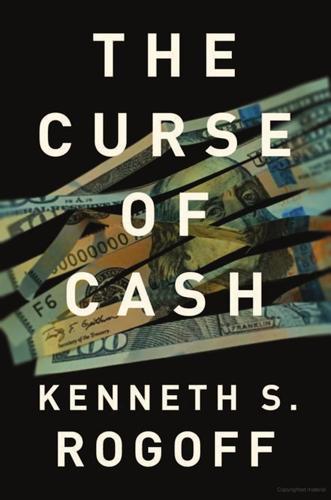
The Curse of Cash
by
Kenneth S Rogoff
Published 29 Aug 2016
Review of Economic Studies 81 (2): 725–60. Farhi, Emmanuel, and Ivan Werning. 2016. “A Theory of Macroprudential Policies in the Presence of Nominal Rigidities” (May). Mimeo, Harvard University, Cambridge, MA. Forthcoming in Econometrica. Federal Deposit Insurance Corporation. 2014. “2013 FDIC National Survey of Unbanked and Underbanked Households.” Washington, DC. Available at https://www.fdic.gov/householdsurvey/. Federal Reserve Bank of Boston. 2012. “Diary of Consumer Payment Choice.” Boston. ———. 2013. “Survey of Consumer Payment Choice.” Boston. Federal Reserve Bank of San Francisco. 2004. “How Much Currency Is Circulating in the Economy, and How Much of It Is Counterfeit?”
…
See also Bank of England United Nations Office on Drugs and Crime, 69, 74, 240n34 United States: Automated Clearing House system, 103; Bitcoin, regulation of, 210; cash circulating, amount of, 31–33; corruption in, 70–71; cost in GDP of buying back all paper currency, 217; counterfeiting, efforts to suppress, 77–78; currency entering or leaving the country, requirement to report large amounts of, 41; currency/GDP ratio, 1948–2015, 33, 36–37; currency/GDP ratio, 1995, 46; currency held by consumers, 3, 49–52; currency of, international significance of, 15–16; currency per capita, 37–38, 40; currency usage, 53–54; discount rate cuts in response to recent crises, 131–32; double-digit inflation, 183; foreign holdings of currency, 39–42, 236n19; foreign holdings of currency, 1985–2015, 45; foreign holdings of currency, estimating, 42–45; gold standard, post–World War I adjustments to, 29; the government’s profit from printing money, 81–82 (see also seigniorage); illegal drug market, estimated size of, 69; inflationary periods in, 27–28; Kleptocracy Asset Recovery Initiative, 72; large-denomination notes, 3, 31; negative interest rates in response to the financial crisis, 123; New York Federal Reserve discount rates, 1929–1939, 128–29; nominal policy interest rates, 2000–2015, 130; $100 bills, rise in demand for, 32–33; $100 North Korean counterfeit “supernote,” 78; paper currency, profits from monopoly on, 217; paper currency in colonial, 26–27; paper currency phaseout, costs and benefits of, 88–89; paper currency supply in small bills, percentage of, 85; payments by instrument type, 54; payments per dollar amount per consumer, 54; phaseout of large-denomination paper currency, proposal for, 95; quantitative easing in, 140–42; revenue as a percentage of GDP, 2006–2015, 83–84; scanner data from retail transactions, 56–57; sexual exploitation in, 74; short-term market interest rates, 1929–1939, 129; tax evasion in, 60–61, 83; terrorism and efforts to tighten enforcement of money-laundering regulations, 77; unauthorized immigrants in, 75; the unbanked and underbanked in, 98; underground economy, estimated size of, 62–63; Volcker’s disinflation effort, 119 universal financial inclusion, 98–100 Velde, François R., 19, 234n13 Venezuela, 184 Vietnam, 191 Vissing-Jorgensen, Annette, 141 Volcker, Paul, 119, 189, 191 Wallace, Neil, 104–5, 225–26 Wallace conjecture, 105, 225–26 Walsh, Carl, 231 Wang, Zhu, 56 Weber, Guglielmo, 239n13 Weber, Warren E., 234n13 Werning, Ivan, 251n3 White, Walter, 240n27 White, William, 176 Williams, John C., 133, 244n11, 245n17 Wolman, Alexander, 56, 244n11, 255n9 Wonderful Wizard of Oz, The (Baum), 192 Woodford, Michael, 145, 227, 230, 243n9 Wu, Jing Cynthia, 244n5, 247n28 Xerxes (king of Persia), 18 Xia, Fan Dora, 244n5, 247n28 Xi Jinping (president of People’s Republic of China), 71 Xu Caihou, 71 Yellen, Janet, 229, 255n5 zero bound constraint, 4–5, 119–27; black hole, similarity to, 124; consumption taxes as approach to, 156–57; fiscal policy and, 249n12; forward guidance as approach to, 145–46; higher inflation targets as approach to, 147–51; historical experiences with, 128–32; macroeconomic stabilization policy and, 124–25; mitigating, options for, 125–27; monetary policy and, 123–24, 227–30; opportunistic fiscal policy as approach to, 154–56; previous experiences of, 122; quantitative easing as approach to (see quantitative easing); quantitative implications of, literature on, 132–35; reemergence of, reasons for, 120–22; relaxing the rigidity of the inflation-targeting framework as approach to, 152–54; targeting nominal GDP as approach to, 151–52.

The Truth Machine: The Blockchain and the Future of Everything
by
Paul Vigna
and
Michael J. Casey
Published 27 Feb 2018
CHAPTER SEVEN After a long multi-decade fight with the city: Jorge Salomón, “El barrio Charrúa, una pequeña Bolivia en el sur de Buenos Aires,” El País, February 12, 2016, http://www.elpaisonline.com/index.php/2013-01-15-14-16-26/sociedad/item/204708-el-barrio-charrua-una-pequena-bolivia-en-el-sur-de-buenos-aires. Hernando de Soto estimates that: Hernando de Soto, The Mystery of Capital: Why Capitalism Triumphs in the West and Fails Everywhere Else (Basic Books, 2000). 7.7 percent of the population is “unbanked,”: Lori London, “The Top 10 Unbanked and Underbanked Cities,” goEBT, March 29, 2017, https://www.goebt.com/the-top-10-unbanked-and-underbanked-cities/. For the more than 2 billion adults worldwide: Global Findex Database, World Bank, 2014, http://www.worldbank.org/en/programs/globalfindex. UN’s plan to eradicate global poverty: Sustainable Development Goals, United Nations, http://www.un.org/sustainabledevelopment/poverty/.

The Color of Money: Black Banks and the Racial Wealth Gap
by
Mehrsa Baradaran
Published 14 Sep 2017
The black community has historically been under the latter system, having been left out of the former. This has come at great expense to that community. Richard Thaler and Cass Sunstein found that blacks pay on average of $425 more for loans than white customers.87 Most black neighborhoods are “banking deserts," neighborhoods abandoned by mainstream banks.88 The FDIC’s surveys on the “unbanked and underbanked" reveal that 60 percent of blacks are either unbanked or underbanked.89 In striking contrast, only 3 percent of whites do not have a bank account and 15 percent are underbanked. Those without bank accounts pay up to 10 percent of their income, or around $2,400 per year, just to use their money.90 That is a meaningful amount of money for low-income Americans, and it is being sucked up by alternative financial services.
…
Russell D. Kashian, Ran Tao, and Claudia Perez-Valdez, “Banking the Unbanked: Bank Deserts in the United States," 1, http://swfa2015.uno.edu/F_Banking /paper_90.pdf. 89. Susan Burhouse, Karyen Chu, Ryan Goodstein, Joyce Northwood, Yazmin Osaki, and Dhruv Shar, “2013 FDIC National Survey of Unbanked and Underbanked Households," FDIC, October 2014, https://www.fdic.gov/householdsurvey /2013report.pdf. 90. KPMG, “Serving the Underserved Market, 2011," 1, http://www.kpmg.com/US /en/IssuesAndInsights/ArticlesPublications/Documents/serving-underserved -market.pdf. 91. Frank Bass and Dakin Campbell, “Bank Branches Disappear from Poor Neighborhoods Like Longwood, Bronx," Bloomberg, May 9, 2013. 92.
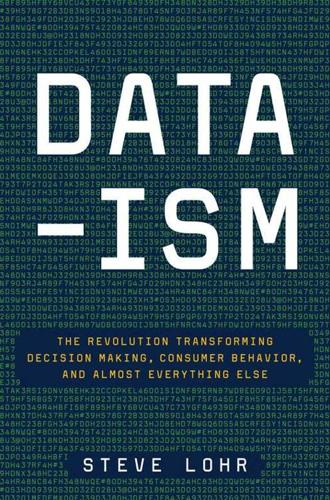
Data-Ism: The Revolution Transforming Decision Making, Consumer Behavior, and Almost Everything Else
by
Steve Lohr
Published 10 Mar 2015
Consider start-up ZestFinance: Douglas Merrill’s descriptions and quotes come from an interview on Oct. 30, 2013. fees paid by payday borrowers: For the average borrowers and amounts outstanding, Merrill did his own current estimates as of late 2013. But he also referenced the Federal Deposit Insurance Corporation’s report in September 2012, 2011 FDIC National Survey of Unbanked and Underbanked Households. http://www.fdic.gov/householdsurvey/2012_unbankedreport.pdf. And he also referred to a July 2012 report by the Pew Charitable Trusts, Payday Lending in America: Who Borrows, Where They Borrow, and Why. http://www.pewtrusts.org/en/research-and-analysis/reports/2012/07/19/who-borrows-where-they-borrow-and-why.
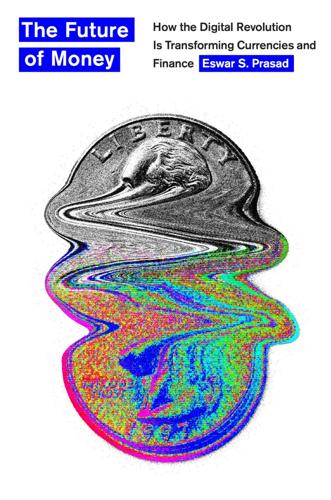
The Future of Money: How the Digital Revolution Is Transforming Currencies and Finance
by
Eswar S. Prasad
Published 27 Sep 2021
The latter term refers to households that had, in the previous twelve months, used an “alternative financial services provider” for one of these products or services: money orders, check cashing, international remittances, payday loans, refund anticipation loans, rent-to-own services, pawnshop loans, or auto title loans. FDIC statistics on financial inclusion in the United States are available at Federal Deposit Insurance Corporation, FDIC National Survey of Unbanked and Underbanked Households, October 2018, https://economicinclusion.gov/downloads/2017_FDIC_Unbanked_Underbanked_HH_Survey_ExecSumm.pdf. The survey found that proportions of the unbanked and underbanked were higher among lower-income households, less educated households, younger households, Black and Hispanic households, working-age disabled households, and households with volatile income. The New York City Council took the legislative action on January 23, 2020.
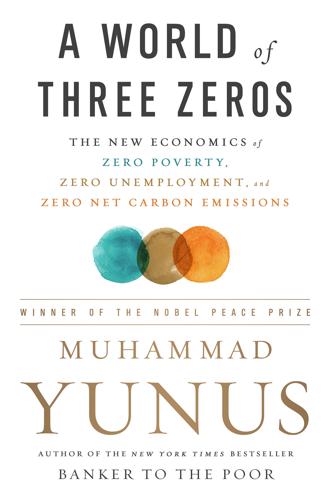
A World of Three Zeros: The New Economics of Zero Poverty, Zero Unemployment, and Zero Carbon Emissions
by
Muhammad Yunus
Published 25 Sep 2017
I have been advocating for years to create new banking laws to allow the setting up of banks for the poor as opposed to the present laws focused on creating banks for the rich. Doing patchwork on the existing laws to allow noncollateralized lending to the unbanked can have very little success—especially while the need for banking for the unbanked and underbanked is so vast. I try to present the case by pointing out that financial services are the oxygen of individual economic life. This oxygen is delivered extremely generously to the topmost people; in fact, they enjoy a kind of economic fire that sucks up nearly all the oxygen that is available.

Smart Money: How High-Stakes Financial Innovation Is Reshaping Our WorldÑFor the Better
by
Andrew Palmer
Published 13 Apr 2015
“Withering Away,” Economist, May 19, 2012. 4. Harry DeAngelo and René Stulz, “Why High Leverage Is Optimal for Banks” (NBER Working Paper 19139, August 2013). NOTES TO CHAPTER 8 1. Victor Stango, “Are Payday Lending Markets Competitive?” Regulation (Fall 2012); “National Survey of Unbanked and Underbanked Households” (Federal Deposit Insurance Corporation, 2011). 2. “Margin Calls,” Economist, February 16, 2013. 3. Meta Brown et al., “The Financial Crisis at the Kitchen Table: Trends in Household Debt and Credit,” Current Issues in Economics and Finance 19 (2013). 4. Atif Mian and Amir Sufi, “The Consequences of Mortgage Credit Expansion: Evidence from the 2007 Mortgage Default Crisis” (NBER Working Paper 13936, April 2008). 5.
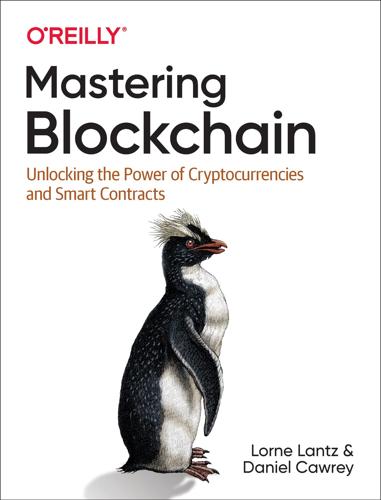
Mastering Blockchain: Unlocking the Power of Cryptocurrencies and Smart Contracts
by
Lorne Lantz
and
Daniel Cawrey
Published 8 Dec 2020
After the departure of Joyce Kim, the Foundation began a long pivot, founding a company called Lightyear.io in 2017 (which became Interstellar in 2018 after acquiring the blockchain company Chain) to promote and encourage adoption of the protocol. Like Ripple, Stellar is focusing on cross-border payments, albeit with a more unbanked and underbanked bent, attempting to provide services to those who lack financial access. Scaling Blockchains In technology terms, scaling is the ability of a network to dynamically change resource allocation while improving or maintaining efficiency. Scaling has been a challenge as Bitcoin has grown: as more transactions end up on the blockchain, the network needs to continue providing a cheap and easy way to transact.
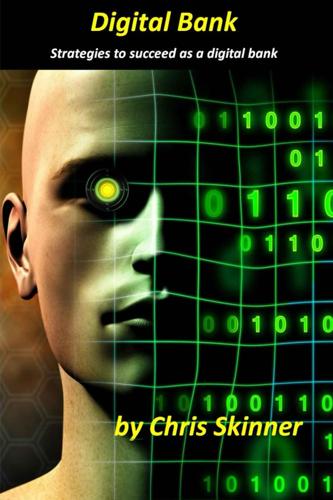
Digital Bank: Strategies for Launching or Becoming a Digital Bank
by
Chris Skinner
Published 27 Aug 2013
The discussion of their success is covered later in this journal in my interview with John Maynard, but the key comment he makes is that since M-PESA launched in 2007, the number of people who now have bank accounts with the traditional banks has almost quadrupled. The reason? As mobile money provides inclusion for the unbanked and underbanked, they become recognised as financially viable citizens and therefore for financial inclusion by being banked. Similarly, when banks find they cannot offer services to customers through this credit crisis that were previously offered, such as credit, other services gain traction. This is clear from the rise of crowdfunding platforms like kickstarter and social lending services like Zopa, Smava and Prosper.

Frugal Innovation: How to Do Better With Less
by
Jaideep Prabhu Navi Radjou
Published 15 Feb 2015
In June 2014, AmEx launched a Financial Innovation Lab, where researchers and counsellors work together to support credit building and savings; the lab’s results will be made publicly available. Through these multiple initiatives, AmEx is attempting to understand and solve a complex, multi-dimensional socio-economic problem. The unbanked and underbanked spend 10% of their $1 trillion disposable income on fees, the same amount as they spend on food. Schulman asks:13 “Imagine if you could turn loose almost $100 billion back into the economy?” Engage restless entrepreneurs, hackers and tinkerers Airbnb, an online short-let rental company, was launched in 2008 by Brian Chesky and Joe Gebbia, two young people with no experience of the hotel industry.

The Future Is Faster Than You Think: How Converging Technologies Are Transforming Business, Industries, and Our Lives
by
Peter H. Diamandis
and
Steven Kotler
Published 28 Jan 2020
With AI, huge groups of people can come together, share financial information, and pool risk, becoming the peer-to-peer market now known as “crowdlending.” Prosper, Funding Circle, and LendingTree are three examples in a market expected to grow from $26.16 billion in 2015 to $897.85 billion by 2024. A different example is the Smart Finance Group. Created in 2013 to serve China’s massive unbanked and underbanked population, Smart Finance uses an AI to comb a user’s personal data—social media data, smartphone data, educational and employment history, etc.—to generate a reliable credit score nearly instantly. With this method, they can approve a peer-to-peer loan in under eight seconds, including microloans to the unbanked.
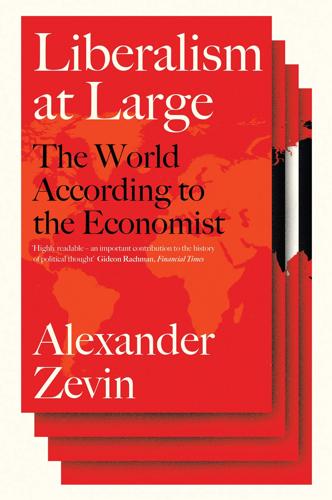
Liberalism at Large: The World According to the Economist
by
Alex Zevin
Published 12 Nov 2019
In red, white and black, the cover read ‘Pro Logo’, and savaged the Canadian activist Naomi Klein for her ‘utterly wrong-headed’ No Logo (1999), the best-selling ‘bible of the anti-globalisation movement’.49 For his part, Emmott spied untrammelled vistas for financial innovation until the end. In his last signed piece in 2006, he hailed US banks for entering sectors served only by payday lenders and pawnbrokers. Citibank signed an agreement with 7-Eleven to put cash machines in 5,500 stores, while credit card companies ‘targeted the unbanked and under-banked’ – poor minorities and immigrants, who stood to gain from access to cheaper credit. (Banks anticipated culling $9 billion in fees from them, and that was ‘before any cross-selling of other products’.) The subprime mortgage crisis hit the next year. Among the community banks Emmott cited as paragons, just one limped into 2012.50 Yet the crash barely checked his stride.